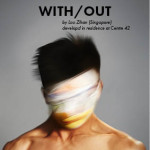“On the memory of objects“
Reviewer: Edward Eng
Performance: 25 January 2019
In Catamite, Loo Zihan investigates the histories and futures of objects. The format is relatively straightforward: he shares his own artistic journey and stories from his research, and interspersing them with exercises to excavate our relationship with our objects.
Loo starts by asking us to lay out all of our personal belongings, and contemplate which object is most special. He then recounts his art-activism related to his research into Section 377A, while sharing with us objects such as a bellydancing vest, a BDSM whip, and a prop candle from his interpretation of the late Paddy Chew’s Completely With/Out Character. We are invited to feel and even take in the scent of each object.
This act of holding objects feels matter-of-fact at first, but when I hold Chew’s candle, it becomes unexpectedly sentimental – the candle was present in all three versions of Chew’s and Loo’s monologue. It is blockish, and holds the weight of many hearts.
Back to our own objects. We are asked to leave something of ours on a table, and choose something that belongs to another audience member. I leave my iPod, and pick up someone’s keys.
After this brief exercise, Loo returns to the more factual elements of the piece, and tells us his research on Section 377A culminated in the case of one catamite – a young male prostitute – in colonial Singapore. We are then roped in to reenact the catamite’s trial using Loo’s objects. Taking on the role of the judge, I wear the wig from Loo’s earlier work, I am LGB. The effect is silly, but it adds an uncomfortable sense of momentousness to the whole thing.
For Loo, the story of the catamite essentially embodies what Section 377A stands for: a law borne of colonial inequities. It was an unfair trial where the local catamite – the receiving partner in the act of sodomy – was portrayed as a deviant who tricked the colonialist.
However, I find that it was rather limiting to reenact the trial scene, as it seems to suggest that object-memory is potent because humanity is constantly in flux, not because the colonial fictionalisation is inherently bad. What, for instance, was the judge feeling when he examined the catamite? The drama of Loo’s point loses steam here, since the performance is unrehearsed and not embodied.
In the end, it is the object exercises – and not the catamite’s story – that pieces my emotional defences. In the last segment, Loo asks us to write a letter for the object we picked up from someone else. I examine the Tokyo Disneyland keychain attached to the keys, and a rush of worry washes over me as I feel that I cannot do its memory justice.
So I write about where the metals were mined. I consider the keys’ purpose. Are they are even for their owner’s house? Maybe they unlock her parents’ door? I imagine that perhaps she has not even been to Disneyland.
Loo’s triumph lies in weaponising our imagination to see our own stories, and the possibility of others’. Like me, the owner of the keychain picked it up somewhere. But here I am, thinking about where it came from, and where it would go.
Do you have an opinion or comment about this post? Email us at info@centre42.sg.
ABOUT THE PRODUCTION
CATAMITE by Loo Zihan
25 – 27 January 2019
Centre 42 Black Box
ABOUT THE REVIEWER
Edward is a playwright whose work has been performed locally as well as in China and across the UK. He read Philosophy, Politics and Economics at university and is interested in using the lenses he has picked up there to celebrate the nooks and crannies of Singapore theatre.





